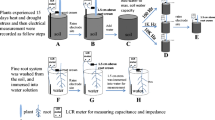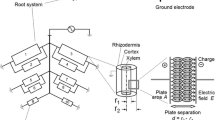Abstract
Purpose
Electrical capacitance (EC) is widely used to measure root traits especially in hydroponic and wet soil environments, but its feasibility was recently questioned due to the possible leakage of electrical current before entering the root system. To investigate whether the current can travel deeper in woody roots, EC was evaluated in cotton (Gossypium hirsutum L.) grown under different soil moisture conditions (two rounds of pot experiments, one PVC tube experiment and one field experiment).
Methods
In these experiments, electrical capacitance of the root (ECroot) was recorded before and after severing roots, and immediately afterward, the roots were collected to measure root dry weight, surface area, length, and volume.
Results
The results showed that ECroot was significantly reduced after root cutting especially under dry conditions in the three experiments. The PVC tube experiment further demonstrated that root cutting did not significantly affect the changes in ECroot measured at different soil layers under dry conditions possibly suggesting that the current could flow into the deep roots under these conditions. Moreover, incorporating root tissue density and soil moisture into the prediction model can improve the predictive accuracy of ECroot. In contrast, ECroot was less affected by root cutting under wet soil conditions, indicating that it may not directly measure roots under these conditions.
Conclusions
ECroot shows the potential to directly quantify root traits under dry conditions rather than wet conditions.







Similar content being viewed by others
Abbreviations
- EC:
-
Electrical capacitance
- ECroot :
-
Electrical capacitance of the root
- ECsoil :
-
Electrical capacitance of the soil
- RTD:
-
Root tissue density
References
Atkinson JA, Pound MP, Bennett MJ, Wells DM (2019) Uncovering the hidden half of plants using new advances in root phenotyping. Curr Opin Biotec 55:1–8. https://doi.org/10.1016/j.copbio.2018.06.002
Aubrecht L, Stanek Z, Koller J (2006) Electrical measurement of the absorption surfaces of tree roots by the earth impedance method: 1. Theory Tree Physiol 26(9):1105–1112. https://doi.org/10.1093/treephys/26.9.1105
Cao Y, Repo T, Silvennoinen R, Lehto T, Pelkonen P (2010) An appraisal of the electrical resistance method for assessing root surface area. J Exp Bot 61(9):2491–2497. https://doi.org/10.1093/jxb/erq078
Cassiani G, Boaga J, Vanella D, Perri MT, Consoli S (2015) Monitoring and modelling of soil-plant interactions: the joint use of ERT, sap flow and eddy covariance data to characterize the volume of an orange tree root zone. Hydrol Earth Syst Sci 19(5):2213–2225. https://doi.org/10.5194/hess-19-2213-2015
Cermak J, Ulrich R, Stanek Z, Koller J, Aubrecht L (2006) Electrical measurement of tree root absorbing surfaces by the earth impedance method: 2. Verification based on allometric relationships and root severing experiments. Tree Physiol 26 9:1113–1121. https://doi.org/10.1093/treephys/26.9.1113
Chloupek O (1972) The relationship between electric capacitance and some other parameters of plant roots. Biol Plant 14(3):227–230. https://doi.org/10.1007/bf02921255
Cimpoiasu MO, Kuras O, Pridmore T, Mooney SJ (2020) Potential of geoelectrical methods to monitor root zone processes and structure: A review. Geoderma 365:18. https://doi.org/10.1016/j.geoderma.2020.114232
Corona-Lopez DDJ, Sommer S, Rolfe SA, Podd F, Grieve BD (2019) Electrical impedance tomography as a tool for phenotyping plant roots. Plant Methods 15(1):49. https://doi.org/10.1186/s13007-019-0438-4
Cseresnyés I, Fekete G, Végh KR, Székács A, Mörtl M, Rajkai K (2013a) Monitoring of herbicide effect in maize based on electrical measurements. Int Agrophys 26(3):243–247. https://doi.org/10.2478/v10247-012-0036-4
Cseresnyés I, Rajkai K, Vozáry E (2013b) Role of phase angle measurement in electrical impedance spectroscopy. Int Agrophys 27:377–383. https://doi.org/10.2478/intag-2013-0007
Cseresnyés I, Rajkai K, Takács T, Vozáry E (2018a) Electrical impedance phase angle as an indicator of plant root stress. Biosyst Eng 169:226–232. https://doi.org/10.1016/j.biosystemseng.2018.03.004
Cseresnyés I, Szitár K, Rajkai K, Füzy A, Mikó P, Kovács R, Takács T (2018b) Application of electrical capacitance method for prediction of plant root mass and activity in field-grown crops. Front Plant Sci 9:11. https://doi.org/10.3389/fpls.2018.00093
Cseresnyés I, Takács T, Sepovics B, Kovács R, Füzy A, Parádi I, Rajkai K (2019) Electrical characterization of the root system: a noninvasive approach to study plant stress responses. Acta Physiol Plant 41(10):169. https://doi.org/10.1007/s11738-019-2959-x
Cseresnyés I, Rajkai K, Szitár K, Radimszky L, Ónodi G, Kröel -Dulay G, (2020a) Root capacitance measurements allow non-intrusive in-situ monitoring of the seasonal dynamics and drought response of root activity in two grassland species. Plant Soil 449(1–2):423–437. https://doi.org/10.1007/s11104-020-04505-4
Cseresnyés I, Vozáry E, Rajkai K (2020b) Does electrical capacitance represent roots in the soil? Acta Physiol Plant 42(5):71. https://doi.org/10.1007/s11738-020-03061-9
Dalton FN (1995) In-situ root extent measurements by electrical capacitance methods. Plant Soil 173(1):157–165. https://doi.org/10.1007/bf00155527
Dietrich RC, Bengough AG, Jones HG, White PJ (2012) A new physical interpretation of plant root capacitance. J Exp Bot 63(17):6149–6159. https://doi.org/10.1093/jxb/ers264
Dietrich RC, Bengough AG, Jones HG, White PJ (2013) Can root electrical capacitance be used to predict root mass in soil? Ann Bot-London 112(2):457–464. https://doi.org/10.1093/aob/mct044
Ehosioke S, Nguyen F, Rao S, Kremer T, Placencia-Gomez E, Huisman JA, Kemna A, Garré JM, S, (2020) Sensing the electrical properties of roots: A review. Vadose Zone J 19(1):29. https://doi.org/10.1002/vzj2.20082
Ellis TW, Murray W, Kavalieris L (2013a) Electrical capacitance of bean (Vicia faba) root systems was related to tissue density-a test for the Dalton Model. Plant Soil 366(1–2):575–584. https://doi.org/10.1007/s11104-012-1424-z
Ellis TW, Murray W, Paul K, Kavalieris L, Brophy J, Williams C, Maass M (2013b) Electrical capacitance as a rapid and non-invasive indicator of root length. Tree Physiol 33(1):3–17. https://doi.org/10.1093/treephys/tps115
Ginsburg H (1972) Analysis of plant root electropotentials. J Theor Biol 37(3):389-. https://doi.org/10.1016/0022-5193(72)90082-3
Guo L, Chen J, Cui XH, Fan BH, Lin H (2013) Application of ground penetrating radar for coarse root detection and quantification: a review. Plant Soil 362(1–2):1–23. https://doi.org/10.1007/s11104-012-1455-5
Hagrey SA, Petersen T (2011) Numerical and experimental mapping of small root zones using optimized surface and borehole resistivity tomography. Geophysics 76(2):G25–G35. https://doi.org/10.1190/1.3545067
Hermanska A, Streda T, Chloupek O (2015) Improved wheat grain yield by a new method of root selection. Agron Sus Dev 35(1):195–202. https://doi.org/10.1007/s13593-014-0227-4
Liu X, Dong X, Leskovar DI (2016) Ground penetrating radar for underground sensing in agriculture: A review. Int Agrophys 30(4):533–543. https://doi.org/10.1515/intag-2016-0010
Liu XW, Dong XJ, Xue QW, Leskovar DI, Jifon J, Butnor JR, Marek T (2018) Ground penetrating radar (GPR) detects fine roots of agricultural crops in the field. Plant Soil 423(1–2):517–531. https://doi.org/10.1007/s11104-017-3531-3
Lynch JP (2013) Steep, cheap and deep: an ideotype to optimize water and N acquisition by maize root systems. Ann Bot-London 112(2):347–357. https://doi.org/10.1093/aob/mcs293
Lynch J (2019) Root phenotypes for improved nutrient capture: an underexploited opportunity for global agriculture. New Phytol 223(2):548–564. https://doi.org/10.1111/nph.15738
Malavasi UC, Davis AS, Malavasi MdM (2016) Lignin in woody plants under water stress: A review. Floresta e Ambiente 23(4):589–597. https://doi.org/10.1590/2179-8087.143715
Mancuso S (2012) Measuring roots: An updated approach. Springer, Berlin
Mary B, Abdulsamad F, Saracco G, Peyras L, Vennetier M, Meriaux P, Camerlynck C (2017) Improvement of coarse root detection using time and frequency induced polarization: from laboratory to field experiments. Plant Soil 417(1–2):243–259. https://doi.org/10.1007/s11104-017-3255-4
Mary B, Peruzzo L, Boaga J, Schmutz M, Wu Y, Hubbard S, Cassiani G (2018) Small scale characterization of vine plant root water uptake via 3D electrical resistivity tomography and Mise-à-la-Masse method. Hydrol Earth Syst Sci 22(10):5427–5444. https://doi.org/10.5194/hess-22-5427-2018
Mary B, Peruzzo L, Boaga J, Cenni N, Schmutz M, Wu Y, Hubbard SS, Cassiani G (2020) Time-lapse monitoring of root water uptake using electrical resistivity tomography and mise-a-la-masse: a vineyard infiltration experiment. Soil 6(1):95–114. https://doi.org/10.5194/soil-6-95-2020
Metzner R et al (2015) Direct comparison of MRI and X-ray CT technologies for 3D imaging of root systems in soil: potential and challenges for root trait quantification. Plant Methods 11:17. https://doi.org/10.1186/s13007-015-0060-z
Nakhforoosh A, Grausgruber H, Kaul HP, Bodner G (2014) Wheat root diversity and root functional characterization. Plant Soil 380(1-2):211–229. https://doi.org/10.1007/s11104-014-2082-0
Ozier-Lafontaine H, Bajazet T (2005) Analysis of root growth by impedance spectroscopy (EIS). Plant Soil 277(1–2):299–313. https://doi.org/10.1007/s11104-005-7531-3
Paz A, Thorin E, Topp C (2011) Dielectric mixing models for water content determination in woody biomass. Wood Sci Technol 45(2):249–259. https://doi.org/10.1007/s00226-010-0316-8
Peruzzo L et al (2020) Imaging of plant current pathways for non-invasive root Phenotyping using a newly developed electrical current source density approach. Plant Soil 450(1–2):567–584. https://doi.org/10.1007/s11104-020-04529-w
Rabbi SMF, Tighe MK, Warren CR, Zhou Y, Denton MD, Barbour MM, Young IM (2021) High water availability in drought tolerant crops is driven by root engineering of the soil micro-habitat. Geoderma 383. https://doi.org/10.1016/j.geoderma.2020.114738
Rajkai K, Végh K, Nacsa TJAAH (2005) Electrical capacitance of roots in relation to plant electrodes, measuring frequency and root media. Acta Agron Hung 53(2):197–210
Repo T, Zhang G, Ryyppo A, Rikala R (2000) The electrical impedance spectroscopy of Scots pine (Pinus sylvestris L.) shoots in relation to cold acclimation. J Exp Bot 51(353):2095–2107. https://doi.org/10.1093/jexbot/51.353.2095
Song CW, Shen WW, Du L, Wen JL, Lin JX, Li RL (2019) Development and chemical characterization of Casparian strips in the roots of Chinese fir (Cunninghamia lanceolata). Trees-Struct Funct 33(3):827–836. https://doi.org/10.1007/s00468-019-01820-x
Streda T, Haberle J, Klimesova J, Klimek-Kopyra A, Stredova H, Bodner G, Chloupek O (2020) Field phenotyping of plant roots by electrical capacitance - a standardized methodological protocol for application in plant breeding: A review. Int Agrophys 34(2):173–184. https://doi.org/10.31545/intagr/117622
Suseela V, Tharayil N, Orr G, Hu D (2020) Chemical plasticity in the fine root construct of Quercusspp. varies with root order and drought. New Phytol 228(6):1835–1851. https://doi.org/10.1111/nph.16841
Trachsel S, Kaeppler SM, Brown KM, Lynch JP (2011) Shovelomics: high throughput phenotyping of maize (Zea mays L.) root architecture in the field. Plant Soil 341(1–2):75–87. https://doi.org/10.1007/s11104-010-0623-8
Urban J, Bequet R, Mainiero R (2011) Assessing the applicability of the earth impedance method for in situ studies of tree root systems. J Exp Bot 62(6):1857–1869. https://doi.org/10.1093/jxb/erq370
Weigand M, Kemna A (2017) Multi-frequency electrical impedance tomography as a non-invasive tool to characterize and monitor crop root systems. Biogeosciences 14(4):921–939. https://doi.org/10.5194/bg-14-921-2017
Weigand M, Kemna A (2019) Imaging and functional characterization of crop root systems using spectroscopic electrical impedance measurements. Plant Soil 435(1–2):201–224. https://doi.org/10.1007/s11104-018-3867-3
Wu W, Duncan RW, Ma BL (2017) Quantification of canola root morphological traits under heat and drought stresses with electrical measurements. Plant Soil 415(1–2):229–244. https://doi.org/10.1007/s11104-016-3155-z
Zajicova K, Chuman T (2019) Application of ground penetrating radar methods in soil studies: A review. Geoderma 343:116–129. https://doi.org/10.1016/j.Geoderma.2019.02.024
Zhou SX, Walker RR, Edwards E (2020) Decoupled drought responses of fine-root versus leaf acquisitive traits among six Prunus hybrids. J Plant Ecol 13(3):304–312. https://doi.org/10.1093/jpe/rtaa015
Acknowledgements
The authors thank Hanbing Jiang, Shiming Duan, Baoru Li, Na Liu and Xing Guo for helping with field sampling and providing assistance in processing root samples. This study was funded by the International Cooperation Project of MOST (2017YFE0130500) and supported by the State Key Laboratory of North China Crop Improvement and Regulation (NCCIR2020KF-8) and Key Research & Development Program of Hebei Province (20326404D).
Author information
Authors and Affiliations
Corresponding authors
Additional information
Responsible Editor: Zhun Mao.
Publisher’s note
Springer Nature remains neutral with regard to jurisdictional claims in published maps and institutional affiliations.
Supplementary Information
Rights and permissions
About this article
Cite this article
Gu, H., Liu, L., Butnor, J.R. et al. Electrical capacitance estimates crop root traits best under dry conditions—a case study in cotton (Gossypium hirsutum L.). Plant Soil 467, 549–567 (2021). https://doi.org/10.1007/s11104-021-05094-6
Received:
Accepted:
Published:
Issue Date:
DOI: https://doi.org/10.1007/s11104-021-05094-6




